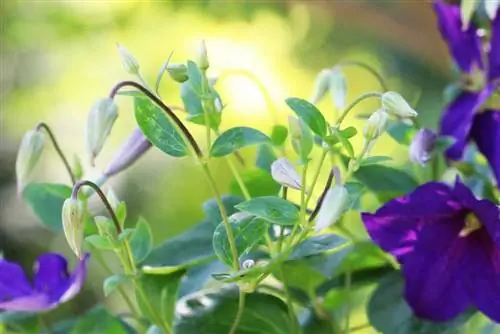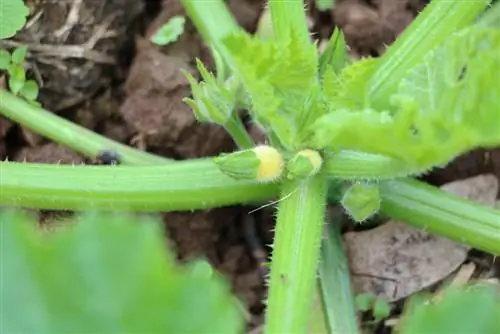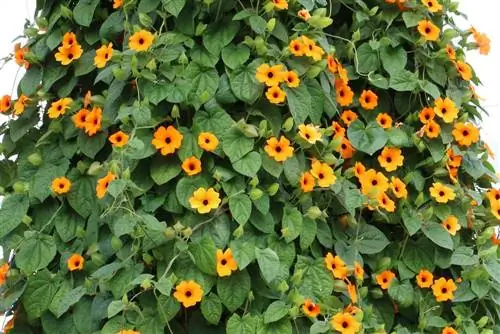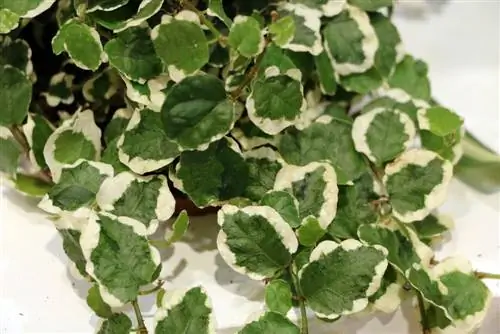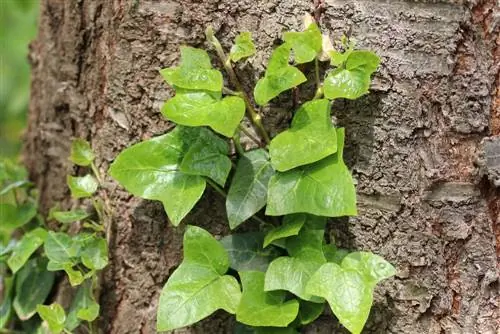- Author admin [email protected].
- Public 2023-12-17 03:39.
- Last modified 2025-06-01 06:48.
Fast-growing balcony plants can be pulled into a wonderful privacy screen thanks to a trellis or other suitable climbing aids, provide shade and can even have a filtering function against dust and dirt. In order to take advantage of these advantages, the right plants must be selected and they must be cared for accordingly. Because some special features can arise, especially when growing in containers.
Fast-growing balcony plants
There are many climbing plants but not all of them are suitable for the balcony. However, the following 10 ways have proven to be effective:
Clematis
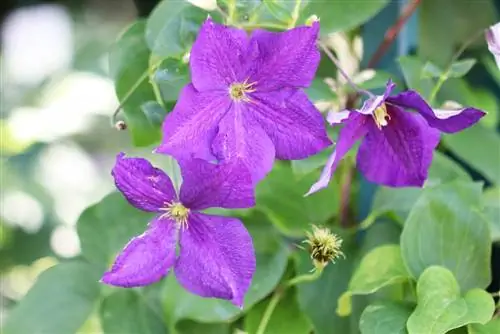
Clematis, also known as clematis, is available in numerous varieties. Small-flowered spring bloomers, such as mountain clematis and alpine clematis, are particularly strong-growing. Sunny balconies facing south or west are recommended as locations. Care should be taken to ensure that the lower 50 centimeters of the plant should be in the shade, while the upper shoots should tolerate and receive a lot of light. If the balcony railing does not provide enough shade, it should be made more opaque with a privacy screen.
Trails made of plastic, rope or wood are recommended for the delicate shoots of clematis. They can burn metal in summer and suffer frost damage in winter. The climbing aid should also be made available to them at an early stage. With enough water and nutrients, clematis grow very quickly. It should also be noted that the climbing aid is a few centimeters away from walls. In this way, the shoots can be well ventilated from all sides.
Tip:
Initially, clematis should be attached to the trellis with wire or thread. In this way they are stabilized and pulled in the desired direction.
Ivy

Ivy develops shoots up to 20 meters long and has adhesive roots. Basically, it doesn't need any trellis support; it also grows over facades and railings - if it is not steered accordingly. This is also absolutely necessary if it is a rental apartment. Because the ivy leaves traces through its adherent roots and is difficult to completely remove.
Tip:
Care should therefore be taken to ensure that it remains on the trellis and does not take on a life of its own. If the shoots cannot be redirected, they should be trimmed. The ivy prefers an area without direct sun. This makes it ideal for shade and partial shade and is ideal as a climbing plant for balconies facing west or north.
Honeysuckle
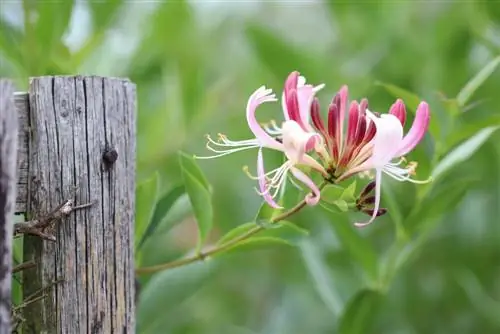
Honeysuckle, also known as honeysuckle, is available in many different varieties. Some are only half a meter high, others eight meters high. Some varieties are evergreen and not all of them are vines. Many honeysuckle varieties have surprisingly fast growth. If you want to get privacy screens particularly quickly, you should choose the evergreen honeysuckle. The plant is also known as Lonicera henryi and grows up to one meter per year.
The honeysuckle is not very demanding in terms of location, but the lighting conditions should suit the respective variety.
Bell Vine
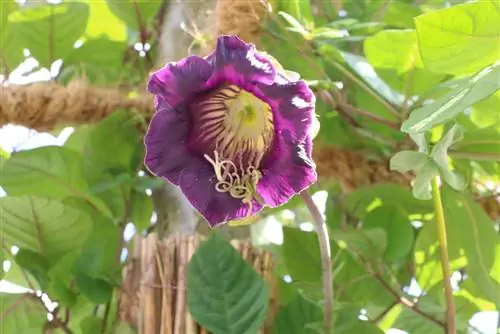
The bell vine is also known as bell vine or claw vine and is fast-growing. It is particularly popular not only because of the privacy protection it creates in a short time, but also because of its enchanting flowers. The location should be in full sun to partial shade. If the bell vine is too dark, growth and flowering will decrease. They should also be protected from wind and sufficiently stabilized. If it is wintered indoors or at least well protected against frost, it is perennial. It is advisable to trim them to around half a meter to a meter high before overwintering. This makes sheltering or wintering indoors easier.
Jasmine

Protection from unwanted looks and sun and a breathtaking scent - that's exactly what jasmine has to offer. It needs a bright location, but reacts sensitively to blazing midday sun and quickly suffers burns. Balconies facing east or west are therefore ideal.
Tip:
Since most jasmine varieties are sensitive to frost, they should not be placed on the balcony too early and should also be kept frost-free in the house over the winter. A blend is recommended in autumn or spring, but should only be radical with real jasmine, as other varieties do not recover from it as quickly.
Nasturtium
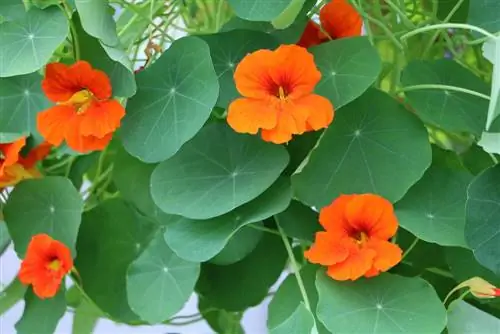
The nasturtium flowers are not only impressive, they are edible, as are the buds and seeds. So if you not only want a privacy screen and shade as a quickly climbing balcony plant, but also want to enrich your menu, this plant is the best choice.
Tip:
For a particularly abundance of flowers, the nasturtium needs a sunny location. In addition, lots of water but economical fertilization. If you want to produce flowers over a longer period of time, pinch off wilted flowers. Additional stabilization on the trellis is not necessary in protected locations. However, nasturtium is only an annual plant. So it has to be placed or drawn again every year.
Black-Eyed Susan
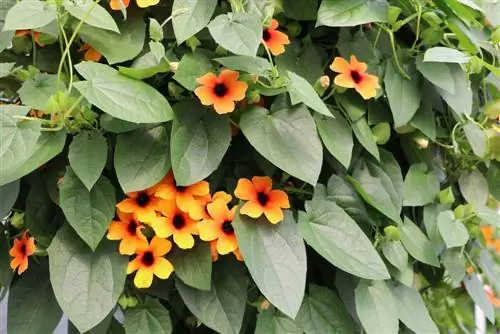
The black-eyed Susan wants to be warm, sunny and protected, then it not only grows quickly, but also produces numerous flowers. If it is watered and fertilized sufficiently, it is quite resilient. The enchanting flowers last until autumn if withered flowers and seed capsules are removed early and regularly.
Tip:
Unfortunately, the black-eyed Susan is often only cultivated as an annual plant. With a bright wintering temperature between 10 and 15 °C, it can provide many years of enjoyment and serve as a privacy screen. To save space in the winter quarters, it can be shortened to a height of 50 centimeters.
Trumpet Flower
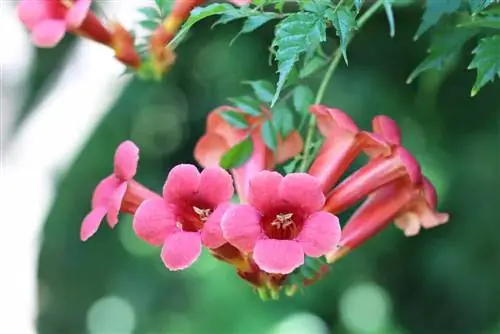
The head in the sun, the roots in the shade - this is what the ideal location for the trumpet flower looks like. With appropriate care and climbing aid, it can quickly become an opaque shade source with rich flowers.
Tip:
So that it can be grown per year, it should be kept cool but frost-free over the winter. What is practical is that it tolerates waste well and can be carried over the cold season to save space.
Wine
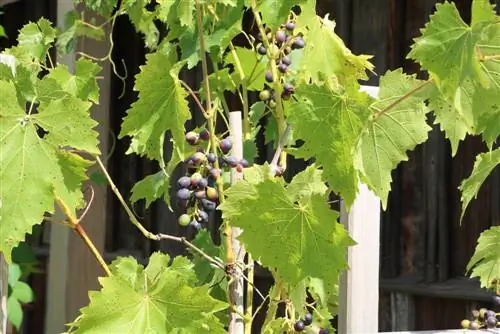
Wine or wild wine is a self-climbing tree and therefore doesn't actually need any climbing aid. So that it doesn't destroy the facade, it should be specifically attached and held to one. Shoots that become independent should be immediately reattached to the trellis or trimmed. Nothing needs to be taken into account when choosing the location for the wild wine. Full sun or shade, the fast-growing balcony plant can spread anywhere. Provided it receives sufficient water and nutrients. Even when blended, wine is robust and easily forgives even radical shortening. The only thing that could be problematic is the bucket, because it has to be as large and stable as possible.
Veca

Vetches enchant with their splendor of flowers and grow quickly, but only reach a height of up to two meters. This is ideal, especially on small balconies, as it means there is no waste and it doesn't get too out of hand. Moderately sunny to semi-shady places are ideal locations. The effort required for watering and fertilizing should not be underestimated, despite moderate sunlight. If you want to leave the vetch on the balcony during the winter, you should choose the perennial vetch. With appropriate protection, this can cope well even in frost.
Selection aids and tips
Trailing, twining and climbing plants can be found in large numbers in stores. However, not every plant is suitable for every balcony. When making your selection, you should therefore pay attention to the following conditions:
- Location and lighting conditions
- Pot and plant size
- Care effort
- Wintering
Location
South side or north sunny or shady? Above all, the lighting conditions at the location play a decisive role in the selection of fast-growing balcony plants. Common ivy also thrives in shade. The clematis, on the other hand, loses its vigor and flowering ability if it does not receive enough sunlight. Additionally, weather conditions should be taken into account. If strong wind and rain are to be expected, you should choose a robust climbing plant.
Bucket
The planter must be as stable and large as possible, because quickly climbing balcony plants require a lot of water and large amounts of nutrients. For perennial plants they should be even larger, as the substrate provides additional frost protection and thus makes overwintering outdoors easier.
Pouring
As mentioned, balcony plants that climb quickly need a lot of water. The rapid growth and increase in leaf mass ensure high consumption and accelerated evaporation. The sunnier the location and the faster the plant grows, the more effort it takes to water. It is therefore important to consider whether daily watering is possible in summer or whether a slower climbing balcony plant should be selected to reduce effort.
Fertilize
The same applies here: the faster the growth, the greater the effort. Since the plants on the balcony are grown in pots, there is less substrate available to them. They are therefore less able to look after themselves than in the wild. Regular and appropriate fertilization is therefore absolutely necessary.
Tip:
Effort and frequency can be reduced if you choose a planter with the largest possible volume and pre-fertilized soil.
Trails

Trellises, rods, wire mesh or ropes - so that the quickly climbing balcony plants can spread as desired and grow specifically as privacy screens or shade, they need appropriate climbing aids. In rental apartments, care should also be taken to ensure that the façade is not affected by the tendrils or has any damaging growth. Trellises can also help here. When choosing, it is important to pay attention to the resistance and durability of the climbing aids. This is especially true for perennial, evergreen climbing plants. The following factors of the individual materials must be taken into account:
Wireframe
Coated metal is less susceptible to weather-related damage. However, scratches or cracks in the coating can also cause them to rust. However, some wire mesh can be easily bent and cut to size, allowing unusual shapes and quick adaptation to the balcony.
Plastic
Over time, plastics become porous in the sun and can fade. However, they are very cheap to buy.
Wood
Natural and decorative, wooden trellises and trellises are available in many designs. However, it should be expected that it can fade, swell and splinter. Wood preservatives can help.
Ropes
In order to serve as a climbing aid, ropes must be tensioned. The assembly is therefore more complex than with the other materials. They can be variably adapted to local conditions, are comparatively light and durable for a long time. Of course, you should choose variants that are weatherproof.
Wintering
Of course, this question does not arise with annual climbing balcony plants, but with perennials it can be problematic. Many plants grown in pots are not nearly as frost-resistant as those grown outdoors. It may be possible to bring it indoors if the above-ground shoots die off in autumn anyway.
Appropriate protection must be provided for everyone else. This should consist of the following components:
- Pot with large volume, the larger, the better the roots are protected
- Set up on a pallet or Styrofoam to attach insulation downwards
- Wrap the pot and, if possible, the plant with garden fleece
- Pile up soil, straw, brushwood or mulch on the ground as additional frost protection
In addition, you should not forget to water the plant on frost-free days and to prevent the soil from drying out completely. Many climbing balcony plants do not freeze to death in winter, but rather dry up.

